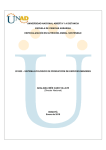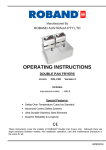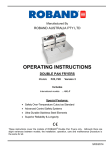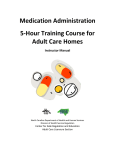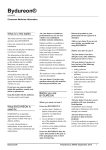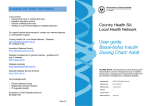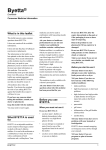Download user manual - Exercise Is Medicine ® Australia
Transcript
Adult pre-exercise screening system (APSS) USER MANUAL This resource was funded by the Australian Government Acknowledgements This resource has been developed by Exercise & Sports Science Australia (ESSA), and funded by the Australian Government under the National Partnership Agreement on Preventive Health. Exercise & Sports Science Australia was supported by Fitness Australia and Sports Medicine Australia and would like to acknowledge the contributions made by: • Prof Kevin Norton, Professor in Exercise Science, University of South Australia • Prof Jeff Coombes, Professor in Exercise Science, University of Queensland •Mrs Anita Hobson-Powell, Executive Officer, ESSA •Mrs Rebecca Johnson, Project Officer, ESSA •Mr Craig Knox, General Manager of Industry Development, Fitness Australia •Mr Nello Marino, Chief Executive Officer, Sports Medicine Australia •Dr Robert Parker, Department Head Children’s Hospital Institute of Sports Medicine, The Children’s Hospital at Westmead •Dr Andrew Williams, Senior Lecturer in Exercise Science, University of Tasmania •Ms Kate Piper, Healthy Living Branch, Population Health Division, Commonwealth Department of Health and Ageing © Exercise & Sports Science Australia V1 (2011) 2 Foreword Exercise & Sports Science Australia, Fitness Australia and Sports Medicine Australia have jointly developed an Adult Pre-Exercise Screening System (APSS) that all associations will recommend to their registrants, members, government and other associated organisations. The aim of this development is to establish a consistent approach for pre-exercise screening and management to ensure that clients achieve better health outcomes and sustained physical activity throughout the lifespan. The health and fitness industry workforce comprises of a range of professionals that vary in individual skills, expertise and qualifications. Before prescribing physical activity or exercise, it is common industry practice for providers who are administering programs to screen individuals prior to commencement of an exercise program. It is expected that the recognition and use of a consistent platform for pre-exercise screening by fitness professionals, exercise physiologists, other allied health practitioners and general practitioners will greatly assist coordination of exercise service delivery. Most importantly, it is anticipated that it will improve identification of risk and subsequent client education and management. Exercise & Sports Science Australia with support from the Commonwealth Department of Health and Ageing and in conjunction with Fitness Australia and Sports Medicine Australia have developed this User Manual with the aim of improving application of the APSS by exercise service providers. It is an informative resource which provides a thorough explanation of terms and process for use. Health and fitness industry exercise service providers are encouraged to use this manual with guidance provided on three stages of pre-exercise screening. Stage 1 may be self-administered and self-evaluated, whilst Stages 2 and 3 require an additional level of industry knowledge and skills. Ultimately, by improving program safety and quality assurance, the APSS seeks to increase the number of people participating in appropriate and safe long-term physical activity or exercise. Anita Hobson-Powell Executive Officer Exercise & Sports Science Australia (ESSA) Nello Marino CEO Sports Medicine Australia Lauretta Stace CEO Fitness Australia Please note: This user manual for the Adult Pre-Exercise Screening System Tool does not provide advice on a particular matter, nor does it substitute for advice from an appropriately qualified medical professional. No warranty of safety should result from its use. The screening system in no way guarantees against injury or death. No responsibility or liability whatsoever can be accepted by Exercise & Sports Science Australia, Fitness Australia or Sports Medicine Australia for any loss, damage or injury that may arise from any person acting on any statement or information contained in the screening tool or this user manual. © Exercise & Sports Science Australia V1 (2011) 3 CONTENTS How to Use this Manual.........................................................page 5 How to use Stage One How to use Stages Two and Three Stage 1 (compulsory).............................................................page 7 Stage 1 is compulsory for individuals wishing to participate in any exercise/ physical activity program. This stage may be self-administered and selfevaluated and will determine if an individual is ready to begin light/moderate intensity exercise/physical activity or if they should seek guidance from a health professional prior to commencing. Stage 2 (optional)................................................................page 10 This stage is to be administered by a qualified exercise professional and will aid in identifying risk factors or other conditions that should be considered when setting or modifying a physical activity/exercise program. Stage 3 (optional)................................................................page 16 This stage involves direct measurement of risk factor variables and requires an additional level of skill and knowledge as well as specialised testing equipment. This stage is to be administered by a qualified exercise professional with specific qualifications in fitness or exercise physiology. It is not expected to become a part of routine pre-exercise screening. References............................................................................page 24 Appendix A - Exercise Intensity Guidelines.........................page 25 Glossary of Terms.................................................................page 26 © Exercise & Sports Science Australia V1 (2011) 4 HOW TO USE THIS MANUAL Introduction: This user manual has been developed by Exercise & Sports Science Australia, Fitness Australia and Sports Medicine Australia and is to be used as a guide for the delivery of the corresponding Adult Pre-exercise Screening System [APSS] Tool. The screening tool has been divided into 3 stages: Stage 1 of the screening tool is compulsory and aims to determine if an individual should seek guidance from a health professional prior to commencing physical activity. Stages 2 & 3 are optional and should be administered by a qualified health professional. The information obtained in these stages will be useful in establishing or modifying a physical activity/exercise program. Each stage of the APSS Tool requires clients to be stratified according to their level of risk of experiencing an adverse event during physical activity. An adverse event refers to an unexpected exercise-related event that occurs as a result of an exercise session, resulting in ill health, physical harm or death to an individual. A Risk Stratification box is provided at the completion of each stage to guide the classification of client risk level and provide a corresponding course of action. How to use Stage 1: Stage 1 is compulsory for individuals wishing to participate in any exercise/physical activity program. This stage may be self-administered and self-evaluated and will determine if an individual is ready to begin light/moderate intensity physical activity or if they should seek guidance from a health professional prior to commencing. Stage 1 (Compulsory) Do I have any medical problems that need to be checked out? No Yes Undertake light/ moderate intensity physical activity Consult a GP or appropriate allied health professional © Exercise & Sports Science Australia V1 (2011) 5 How to use Stages 2 & 3: Stages 2 & 3 are optional and should be administered by a qualified exercise professional. These stages will aid in identifying risk factors or other conditions that should be considered when prescribing or modifying a physical activity/exercise program. Stage 3 involves direct measurement of risk factor variables and requires an additional level of skill and knowledge as well as specialised testing equipment. Further risk factor information: Less than 2 risk factors indicates low risk. Low risk individuals may proceed to exercise at any intensity* they desire. 2 or more risk factors indicates moderate risk. Individuals at moderate risk may participate in a prescribed aerobic physical activity/exercise program at a light or moderate intensity*. In the event of an extreme risk factor or multiple risk factors that in the judgement of the exercise professional present a high risk of an adverse event, individuals should be referred to a GP or appropriate allied health professional. *Please refer to Appendix A – Exercise Intensity Guidelines on page 25 Stage 1 (Compulsory) Do I have any medical problems that need to be checked out? No Yes Stages 2 and 3 (Optional) What other physical or medical conditions might modify my exercise/physical activity program or do I have risk factors that need to be checked out? Help to prescribe or modify physical activity program Undertake light/ moderate intensity physical activity Extreme or multiple risk factors Consult a GP or appropriate allied health professional Low risk individuals may proceed to exercise at any intensity* they desire. Note: Qualified health professional to use professional judgement on what constitutes an extreme risk factor value. Similarly, they should also judge whether a particular combination of risk factors is present that might present a high risk of an adverse event during exercise. © Exercise & Sports Science Australia V1 (2011) 6 Stage One (Compulsory) AIM: to identify those individuals with a known disease, or signs or symptoms of disease, who may be at a higher risk of an adverse event during physical activity/exercise. This stage may be self administered and self evaluated. This screening tool can be administered to both regular and casual users of exercise services if they are beginning an exercise/physical activity program. Once completed, the form should be filed with the clients records for future reference. Stage 1 (Compulsory) Do I have any medical problems that need to be checked out? No Yes Undertake light/ moderate intensity physical activity Consult a GP or appropriate allied health professional Further information regarding Stage 1 questions: 1.Has your doctor ever told you that you have a heart condition or have you ever suffered a stroke? Examples include, but are not limited to: • Angina • Atrial fibrillation • Cardiomyopathy • Congenital heart disease • Coronary angioplasty • Coronary artery bypass • Heart failure • Heart valve disease • Myocardial infarction (heart attack) • Pacemaker insertion • Peripheral vascular disease • Stroke 2. Do you ever experience unexplained pains in your chest at rest or during physical activity/exercise? Unexplained chest pains may be characterised by constriction, burning, knife-like pains and/or a dull ache. © Exercise & Sports Science Australia V1 (2011) 7 3.Do you ever feel faint or have spells of dizziness during physical activity/exercise that causes you to lose balance? Examples of dizziness may include, but are not limited to light-headedness or the feeling of near fainting, loss of balance or other sensations such as floating or swimming. Although dizziness after exercise should not be ignored, this may occur even in healthy individuals. 4.Have you had an asthma attack requiring immediate medical attention at any time over the last 12 months? Medical attention refers to a GP or hospital visit immediately following an asthma attack. It does not include the self administration of Ventolin, Becotide or any other inhalant. 5. If you have diabetes (type I or II) have you had trouble controlling your blood glucose in the last 3 months? “Trouble controlling” usually refers to sustaining a hyperglycaemic (hyper) or hypoglycaemic (hypo) event. Hyperglycaemia is a condition that occurs when blood sugar (glucose) levels remain too high. Blood sugars vary from day to day, however consistently high blood glucose levels of >8 mmol/L over a number of days or a single measure of >15 mmol/L results in hyperglycaemia. Symptoms of hyperglycaemia include: • Blurred vision • Excessive thirst • Frequent urination • Infections (e.g. thrush) • Tiredness • Weight loss Hypoglycaemia is a condition that occurs when blood sugar (glucose) is too low. This occurs when your blood glucose level falls below 3.5 mmol/L, although this can vary. Blood sugars at this level can be considered harmful. Symptoms of hypoglycaemia include: • Anxiety • Cold sweats • Confusion • Convulsions • Difficulty speaking • Dizziness or light-headedness • Double/blurry vision • Irritability • Lack of concentration • Shaking or trembling • Sleepiness • Weakness Sources: International Diabetes Institute (2004); Diabetes Australia (2011) 6. Do you have any diagnosed muscle, bone or joint problems that you have been told could be made worse by participating in physical activity/exercise? Examples include, but are not limited to: Muscle Bone or Joint • Cerebral palsy • Arthritis • Bone fracture • Chronic muscle fatigue • Dislocations • Joint replacement • Multiple sclerosis • Scoliosis • Serious sprains • Muscular dystrophy • Spondylolisthesis • Spondylolysis • Parkinson’s disease • Serious strains © Exercise & Sports Science Australia V1 (2011) 8 7. Do you have any other medical condition/s that may make it dangerous for you to participate in physical activity/exercise? Examples include, but are not limited to: • Acute injury • Cancer • Epilepsy • Limiting back or foot pain • Pregnancy • Transplants Completion of Stage 1 – Risk Stratification Stage 1 (Compulsory) Aim is to identify individuals who may be at a higher risk of an adverse event during physical activity/exercise If an individual answers YES to any of the 7 questions, they are advised to seek guidance from their GP or appropriate allied health professional prior to undertaking physical activity/exercise. If an individual answers NO to all of the 7 questions, and they have no other concerns about their health, they may proceed to undertake light or moderate intensity* physical activity/exercise. *Please refer to Appendix A – Exercise Intensity Guidelines on page 25 © Exercise & Sports Science Australia V1 (2011) 9 Stage Two (Optional) AIM: to identify those individuals with risk factors or other conditions to assist appropriate exercise prescription. This stage is to be administered by a qualified exercise professional (Minimum Certificate III in Fitness with completion of screening and assessment units SISFFIT301A and SISFFIT307A). Stage 2 (Optional) What other physical or medical conditions might modify my exercise/physical activity program or do I have risk factors that need to be checked out? Help to prescribe or modify physical activity program Undertake light/ moderate intensity physical activity Extreme or multiple risk factors Consult a GP or appropriate allied health professional Low risk individuals may proceed to exercise at any intensity* they desire. Note: Qualified health professional to use professional judgement on what constitutes an extreme risk factor value. Similarly, they should also judge whether a particular combination of risk factors is present that might present a high risk of an adverse event during exercise. Further information regarding Stage 2 questions: 1. Age and Gender Both age and gender are to be used in combination to calculate client’s level of risk. Example: Males aged <45 years Females aged <55 years No risk factor accumulated. Place a ‘0’ in the corresponding risk factor box. Males aged ≥45 years Females aged ≥55 years 1 risk factor accumulated. Place a ‘+1’ in the corresponding risk factor box. © Exercise & Sports Science Australia V1 (2011) 10 2. Family history of heart disease (e.g. stroke, heart attack) If the client has a 1st degree relative (parent, sibling, or child) that has a heart disease and is male <55 years, or female <65 years, the client accumulates 1 risk factor. Example: 1st degree relative with heart disease (e.g. parent, sibling, child) No Yes No risk factor accumulated. Place a ‘0’ in the corresponding risk factor box. No Is relative: Male <55 years Female <65 years Yes 1 risk factor accumulated. Place a ‘+1’ in the corresponding risk factor box. PLEASE NOTE: Maximum of 1 risk factor to be added for this question (i.e. no additional risk factors for multiple relatives with heart disease) 3. Do you smoke cigarettes on a daily or weekly basis or have you quit smoking in the last 6 months? This is a YES / NO question. “Smoking” includes tobacco cigarettes and pipe. If the client answers YES (i.e. is reliant on smoking on a daily or weekly basis or has given up within the past 6 months) the client accumulates 1 risk factor. Example: No No risk factor accumulated. Place a ‘0’ in the corresponding risk factor box. Yes 1 risk factor accumulated. Place a ‘+1’ in the corresponding risk factor box. © Exercise & Sports Science Australia V1 (2011) 11 4. Describe your current physical activity/exercise level: Explanation of intensity levels: Intensity Level Definition Examples Sedentary Activities that generally involve sitting or lying and that have little additional movement and a low energy requirement. • Watching TV • Riding in a car • Sitting reading Light An aerobic activity that does not cause a noticeable change in breathing rate. Activity can be sustained for at least 60 minutes. • Washing dishes, hanging washing, ironing , cooking • Working at a computer desk • Performing other office duties Moderate An aerobic activity that is able to be conducted whilst maintaining a conversation uninterrupted. Intensity that may last between 30 and 60 minutes. • Walking • Gentle swimming • Golf • Cycling at a regular pace • Social tennis or doubles tennis • Carrying/lifting light loads Vigorous An aerobic activity in which a conversation generally cannot be maintained uninterrupted. An intensity that may last up to about 30 minutes. • Jogging • Cycling • Aerobics • Competitive tennis • Carrying/lifting heavy loads Source: Norton et al. (2010) From the information collected, calculate the total number of minutes exercised per week. Physical activity level <150 min/week 1 risk factor accumulated. Place a ‘+1’ in the corresponding risk factor box. Physical activity level ≥150 min/week 1 risk factor subtracted. Place a ‘-1’ in the corresponding risk factor box. Please note: Time spent participating in vigorous intensity physical activity when weighted should be doubled. Eg. 60mins of vigorous intensity physical activity when weighted x 2 = 120mins © Exercise & Sports Science Australia V1 (2011) 12 5. BMI – Height and Weight Body Mass Index (BMI) is an internationally recognised index of obesity. BMI classifications can vary according to ethnicity. Please note the table below provides classification ranges for a Caucasian population. Information regarding BMI classification for Asian and Indian populations has been published by the World Health Organisation and is available at www.wpro.who.int/internet/resources. ashx/NUT/Redefining+obesity.pdf. Additionally, BMI classifications differ for Polynesians with further information on classification ranges for this population group published by Swinburn et al. (1999) and available from http://www.nature.com/ijo/journal/v23/n11/pdf/0801053a.pdf Caucasian BMI classification ranges: Classification BMI (kg/m2) Underweight <18.5 Normal range 18.5-24.9 Overweight ≥25.0 Pre-obese 25.0-29.9 Obese I 30.0-34.9 Obese II 35.0-39.9 Obese III ≥40.0 Source: World Health Organisation (2000) To calculate BMI use the following formula: BMI = weight (kg) height (m)2 Example: BMI= 75kg 75kg = = 20.8 2 1.9 m 3.61 (Normal weight for Caucasian classification) Client BMI is <30 No risk factor accumulated. Place a ‘0’ in the corresponding risk factor box. Client BMI is ≥30 1 risk factor accumulated. Place a ‘+1’ in the corresponding risk factor box. 6. Have you ever been told that you have high blood pressure? This is a YES / NO question. You are not required to take the client’s blood pressure. If the client is unsure or does not know then assume ‘NO’. No No risk factor accumulated. Place a ‘0’ in the corresponding risk factor box. Yes 1 risk factor accumulated. Place a ‘+1’ in the corresponding risk factor box. © Exercise & Sports Science Australia V1 (2011) 13 7. Have you been told that you have high cholesterol? This is a YES / NO question. You are not required to take the client’s blood cholesterol. If the client is unsure or does not know then assume ‘NO’. No No risk factor accumulated. Place a ‘0’ in the corresponding risk factor box. Yes 1 risk factor accumulated. Place a ‘+1’ in the corresponding risk factor box. 8. Have you been told that you have high blood sugar? This is a YES / NO question. You are not required to take the client’s blood glucose. If the client is unsure or does not know then assume ‘NO’. No No risk factor accumulated. Place a ‘0’ in the corresponding risk factor box. Yes 1 risk factor accumulated. Place a ‘+1’ in the corresponding risk factor box. Additional information: Responses to the remaining questions in Stage 2 will not accumulate risk factors, but rather provide additional useful information concerning the person’s health status. The exercise professional should use professional judgement and if unsure of the implications of a response, refer on to an allied health or medical practitioner for further advice. 9. Have you spent time in hospital (including day admission) for any medical condition/illness/injury during the last 12 months? If the client answers ‘YES’ to this or any of the next three questions (Questions 10-12), details provided should be used to help determine: 1)If further screening is needed 2)If the client needs to be referred onto an allied health professional for an exercise intervention program 3)A basis for further questioning to help in the design of the client’s exercise program © Exercise & Sports Science Australia V1 (2011) 14 Completion of Stage 2 – Risk Stratification Stage 2 (Optional) Aim is to identify whether an individual is at moderate or low risk of an adverse event during physical activity/exercise At the completion of Stage 2, total all the risk factors from questions 1-8. If the client has less than 2 risk factors, they are deemed to be low risk. If the client has 2 or more risk factors, they are deemed to be moderate risk. Low risk: Individuals may participate in aerobic physical activity/exercise up to a vigorous or high intensity* Moderate risk: Individuals may participate in aerobic activity/exercise at a light or moderate intensity* *Please refer to Appendix A – Exercise Intensity Guidelines on page 25 © Exercise & Sports Science Australia V1 (2011) 15 Stage Three (Optional) This stage is optional. It involves direct measurements of risk factor variables such as body mass index, blood pressure, blood fats and glucose levels. It therefore requires an additional level of skill and knowledge as well as specialised testing equipment. It is not expected this stage will become part of routine pre-exercise screening assessment for most subjects. Rather, this stage will be used primarily by people with specific qualifications in fitness or exercise physiology to be more precise about the risk factor profile of an individual. AIM: to obtain pre-exercise baseline measurements of other recognised cardiovascular and metabolic risk factors. This stage is to be administered by a qualified exercise professional (Measures 1, 2 & 3 – minimum qualification, Certificate III in Fitness; Measures 4 & 5 – minimum level, exercise physiologist). Each question in Stage 3 includes a measurement protocol, current classification range and instructions for risk factor calculation. Stage 3 (Optional) What other physical or medical conditions might modify my exercise/physical activity program or do I have risk factors that need to be checked out? Help to prescribe or modify physical activity program Undertake light/ moderate intensity physical activity Extreme or multiple risk factors Consult a GP or appropriate allied health professional Low risk individuals may proceed to exercise at any intensity* they desire. Note: Qualified health professional to use professional judgement on what constitutes an extreme risk factor value. Similarly, they should also judge whether a particular combination of risk factors is present that might present a high risk of an adverse event during exercise. © Exercise & Sports Science Australia V1 (2011) 16 Further information regarding Stage 3 questions: 1. BMI – Height and weight Body Mass Index (BMI) is an internationally recognised index of obesity. Measurement Protocol: Height is to be measured in metres (m). Weight is to be measured in kilograms (kg). To calculate Body Mass Index (BMI) use the following formula: BMI = weight (kg) height (m)2 Example: BMI= 75kg 75kg = = 20.8 2 1.9 m 3.61 (Normal weight for Caucasian classification) Current Classification Ranges: BMI classifications can vary according to ethnicity. Please note the table below provides classification ranges for a Caucasian population. Information regarding BMI classification for Asian and Indian populations has been published by the World Health Organisation and is available at www.wpro. who.int/internet/resources.ashx/NUT/Redefining+obesity.pdf. Additionally, BMI classifications differ for Polynesians with further information on classification ranges for this population group published by Swinburn et al. (1999) and available from http://www.nature.com/ijo/journal/v23/n11/ pdf/0801053a.pdf Caucasian BMI classification ranges: Classification BMI (kg/m2) Underweight <18.5 Normal range 18.5-24.9 Overweight ≥25.0 Pre-obese 25.0-29.9 Obese I 30.0-34.9 Obese II 35.0-39.9 Obese III ≥40.0 Source: World Health Organisation (2000) Risk Factor Calculation: Client BMI is <30 No risk factor accumulated. Place a ‘0’ in the corresponding risk factor box. Client BMI is ≥30 1 risk factor accumulated. Place a ‘+1’ in the corresponding risk factor box. © Exercise & Sports Science Australia V1 (2011) 17 2. Central waist circumference Waist circumference is to be measured in centimetres (cm). Where possible please use a cloth tape measure to reduce skin compression and improve consistency of measurements. Measurement Protocol: With the subject standing, arms at the sides, feet together, and abdomen relaxed, a horizontal measure is taken at the narrowest part of the torso, ususally at the top of the hip bone. Source: ACSM (2010) Current Classification Ranges: Please note: Like BMI, the relationship between body fat and waist circumference differs between ethnic groups. Cut-off values are thought to be lower for Asians and Indians than for Caucasians. Further information regarding central waist circumference classification for Asian and Indian populations has been published by the National Health & Medical Research Council (2003). Waist circumference values for adult Caucasian men and women Risk of metabolic complications Men Women Increased ≥94 cm ≥80 cm Substantially increased ≥102 cm ≥88 cm Source: Davidson et al. (1999); NH&MRC (2003) FEMALE MALE Risk Factor Calculation: Waist ≤94 cm No risk factor accumulated. Place a ‘0’ in the corresponding risk factor box. Waist >94 cm 1 risk factor accumulated. Place a ‘+1’ in the corresponding risk factor box. Waist ≤80 cm No risk factor accumulated. Place a ‘0’ in the corresponding risk factor box. Waist >80 cm 1 risk factor accumulated. Place a ‘+1’ in the corresponding risk factor box. © Exercise & Sports Science Australia V1 (2011) 18 3. Resting blood pressure (BP) Note: Where possible please use a sphygmomanometer and stethoscope and not an electronic blood pressure machine. Measurement Protocol: Client should be seated quietly for at least 5 minutes in a chair with back support, with their feet on the floor and their arm supported at heart level. Patients should refrain from smoking cigarettes or ingesting caffeine during the 30 minutes preceding the measurement. 1.Wrap the cuff firmly around the upper arm at heart level; align cuff with brachial artery. 2. The bladder within the cuff should encircle at least 80% of the upper arm. Many adults require a large adult cuff. 3. Place stethoscope bell below the space over the brachial artery. 4. Quickly inflate cuff pressure to 20 mmHg above first Korotkoff sound. 5.Slowly release pressure at rate equal to 2 to 5 mmHg per second. 6.Systolic BP (SBP) is the point at which the first of two or more Korotkoff sounds is heard and diastolic BP (DBP) is the point before the disappearance of Korotkoff sounds. 7.Repeat, allowing 1 minute between measures. Source: ACSM (2010) Current Classification Ranges: Blood Pressure (BP) Classification for Adults Category Systolic BP (mmHg) Diastolic BP (mmHg) Normal <120 <80 High-normal 120-139 80-89 Grade 1 hypertension (mild) 140-159 90-99 Grade 2 hypertension (moderate) 160-179 100-109 Grade 3 hypertension (severe) ≥180 ≥110 Source: National Heart Foundation (2008) Systolic BP Risk Factor Calculation: Client SBP is <140 mmHg No risk factor accumulated. Place a ‘0’ in the corresponding risk factor box. Client SBP is ≥140 mmHg 1 risk factor accumulated. Place a ‘+1’ in the corresponding risk factor box. DIASTOLIC BP Or alternatively: Client DBP is <90 mmHg No risk factor accumulated. Place a ‘0’ in the corresponding risk factor box. Client DBP is ≥90 mmHg 1 risk factor accumulated. Place a ‘+1’ in the corresponding risk factor box. © Exercise & Sports Science Australia V1 (2011) 19 4. Fasting lipid profile These assessments are to be undertaken by an exercise physiologist or suitably qualified allied health or medical practitioner. Measurement protocol: Total cholesterol, triglyceride and high-density lipoprotein (HDL) should be measured and low-density lipoprotein (LDL) calculated using a fasting blood sample with individuals having consumed only water for the previous 12 hours. Take a sample using the finger prick method. Safety procedures: This procedure involves potentially infectious material. Adhere to all health and safety regulations to minimise the risk of injury or infection. Disposable gloves should be worn and used in addition to sterile blood lancets. Ensure lancets are safely disposed of after use. Source: National Heart Foundation of Australia & The Cardiac Society of Australia and New Zealand, (2001); Warnick et al. (1994) © Exercise & Sports Science Australia V1 (2011) 20 Risk Factor Calculation: Total cholesterol ≥5.2 mmol/L HDL cholesterol >1.55 mmol/L HDL cholesterol <1.00 mmol/L Triglycerides ≥1.7 mmol/L LDL cholesterol ≥3.4 mmol/L No No risk factor accumulated. Yes 1 risk factor accumulated. Place a ‘+1’ in the corresponding risk factor box. No No risk factor accumulated. Yes 1 risk factor subtracted. Place a ‘-1’ in the corresponding risk factor box. No No risk factor accumulated. Yes 1 risk factor accumulated. Place a ‘+1’ in the corresponding risk factor box. No No risk factor accumulated. Yes 1 risk factor accumulated. Place a ‘+1’ in the corresponding risk factor box. No No risk factor accumulated. Yes 1 risk factor accumulated. Place a ‘+1’ in the corresponding risk factor box. Please Note: Maximum of 1 risk factor to be added for this question © Exercise & Sports Science Australia V1 (2011) 21 5. Fasting blood glucose These assessments are to be undertaken by an exercise physiologist or suitably qualified allied health or medical practitioner. Measurement Protocol: Fasting blood glucose should be calculated using a fasting blood sample with individuals having consumed only water for the previous 12 hours. Measure glucose concentration using an appropriate analyser. Most analysers are available from Diabetes Australia, pharmacies and some diabetes centres. Safety procedures: This procedure involves potentially infectious material. Adhere to all health and safety regulations to minimise the risk of injury or infection. Disposable gloves should be worn and used in addition to sterile blood lancets. Ensure lancets are safely disposed of after use. Source: Diabetes Australia (2009a); Warnick et al. (1994) Current Classification Ranges: Diagnostic Criteria for Diabetes Mellitus (8hr fasting blood glucose test) Diabetes Unlikely <5.50 mmol/L Diabetes Uncertain 5.50-6.9 mmol/L Diabetes Likely ≥7.0 mmol/L Source: Diabetes Australia (2009b) Risk Factor Calculation: Client fasting glucose is <5.5 mmol/L No risk factor accumulated. Place a ‘0’ in the corresponding risk factor box. Client fasting glucose is ≥5.5 mmol/L 1 risk factor accumulated. Place a ‘+1’ in the corresponding risk factor box. © Exercise & Sports Science Australia V1 (2011) 22 Completion of Stage 3 – Risk Stratification Stage 3 (Optional) Aim is to identify whether an individual is at moderate or low risk of an adverse event during physical activity/exercise At the completion of Stage 3, total all the risk factors from Stage 3 and questions 1-4 in Stage 2. Record the risk factor total in the space provided on page 4 of the Screening Tool. If the client has less than 2 risk factors, they are deemed to be low risk. If the client has 2 or more risk factors, they are deemed to be moderate risk. Low risk: Individuals may participate in aerobic physical activity/exercise up to a vigorous or high intensity* Moderate risk: Individuals may participate in aerobic activity/exercise at a light or moderate intensity* *Please refer to Appendix A – Exercise Intensity Guidelines on page 25 © Exercise & Sports Science Australia V1 (2011) 23 REFERENCES American College of Sports Medicine [ACSM]. (2010). ACSM’s guidelines for exercise testing and prescription (8th ed.). Philadelphia: Lippincott, Williams & Wilkins. Davidson, M.H., Hauptman, J., DiGirolamo, M., Foreyt, J.P., Halsted, C.H., Heber, D. et al. (1999). Weight control and risk factor reduction in obese subjects treated for 2 years with orlistat: a randomized controlled trial. Journal of the American Medical Association, 281(3), 235-242. Diabetes Australia (2009a). Blood glucose monitoring. Retrieved from http://www.diabetesaustralia. com.au/Living-with-Diabetes/Type-1-Diabetes/Managing-Type-1-Diabetes/Blood-GlucoseMonitoring/# Diabetes Australia. (2009b). Diabetes management in General Practice: Guidelines for type 2 diabetes. Retrieved from http://www.diabetesaustralia.com.au/PageFiles/763/Diabetes%20 Management%20in%20GP%2009.pdf Diabetes Australia. (2011). What is diabetes? Retrieved from http://www.diabetesaustralia.com.au/en/ Understanding-Diabetes/What-is-Diabetes/ International Diabetes Institute. (2004). Hyperglycaemia. Retrieved from http://crlnsw.com.au/fileadmin/ user_upload/National_Sports_Trainers_Scheme/HyperHighbloodglucoselevels.pdf National Health & Medical Research Council [NH&MRC]. (2003). Clinical practice guidelines for the management of overweight and obesity in adults. Canberra: Commonwealth of Australia. National Heart Foundation of Australia. (2008). Guide to management of hypertension. Retrieved from http://www.heartfoundation.org.au/SiteCollectionDocuments/ HypertensionGuidelines2008to2010Update.pdf National Heart Foundation of Australia & The Cardiac Society of Australia and New Zealand. (2001). Lipid management guidelines – 2001. The Medical Journal of Australia, 175, s57-s88. Norton, K., Norton, L., & Sadgrove, D. (2010). Position statement on physical activity and exercise intensity terminology. Journal of Science and Medicine in Sport, 13, 496-502. Swinburn, B.A., Ley, S.J., Carmichael, H.E., & Plank, L.D. (1999). Body size and composition in Polynesians. International Journal of Obesity, 23(11), 1178-1183. Warnick, G.R., Leary, E.T., Ammirati, E.B., & Allen, M.P. (1994). Cholesterol in fingerstick capillary specimens can be equivalent to conventional venous measurements. Archives of Pathology & Laboratory Medicine, 118(11), 1110-1114. World Health Organisation [WHO]. (2000). Obesity: preventing and managing the global epidemic. Report of a WHO consultation. WHO Technical Report Series, 894(3), 1-253. © Exercise & Sports Science Australia V1 (2011) 24 Exercise intensity guidelines Intensity category Sedentary Light Moderate Vigorous High Heart rate measures Perceived exertion measures < 40% HRmax RPE# < 1 (very, very weak) 40 < 55% HRmax RPE# 1-2 (very weak - weak) RPE# 3-4 55 < 70% HRmax (moderate somewhat strong) 70 < 90% HRmax RPE# 5-6 ≥ 90% HRmax RPE ≥ 7 Source: Norton et al. (2010) © Exercise & Sports Medicine Australia V1 (2011) (strong) # (very strong) # = Borg’s RPE scale, category scale 0-10 25 Descriptive measures •Activities that usually involve sitting or lying and that have little additional movement and a low energy requirement •An aerobic activity that does not cause a noticeable change in breathing rate •An intensity that can be sustained for at least 60 minutes •An aerobic activity that is able to be conducted whilst maintaining a conversation uninterrupted •An intensity that may last between 30 and 60 minutes •An aerobic activity in which a conversation generally cannot be maintained uninterrupted •An intensity that may last up to about 30 minutes •An intensity that generally cannot be sustained for longer than about 10 minutes GLOSSARY OF TERMS Acute injury: Injury of short duration, rapid, and abbreviated in onset. Angina: Chest pain due to an inadequate supply of oxygen to the heart muscle. The pain is typically severe and crushing, and it is characterised by a feeling of pressure and suffocation just behind the breastbone. Angina can accompany or be a precursor of a heart attack. Arthritis: Inflammation of one or more joints. Inflamed joints can be characterised by swelling, stiffness, pain, warmth, diminished range of motion and redness of the overlying skin. Atrial fibrillation: An abnormal and irregular heart rhythm in which electrical signals are generated chaotically throughout the upper chambers (atria) of the heart. Bone fracture: A break in the bone. Although usually a result of trauma, a fracture can be the result of an acquired disease of bone, such as osteoporosis, or of abnormal formation of bone. Brachial artery: The artery that runs from the shoulder down to the elbow. Cardiomyopathy: Disease of the heart muscle. Cerebral palsy: An abnormality of motor function (the ability to move and control movements) that is acquired at an early age, usually less than 1 year, and is due to a brain lesion that is non-progressive. Chronic muscle fatigue: A condition of the muscle in which its capacity to produce maximum voluntary action, or to perform a series of repetitive actions, is reduced. Congenital heart disease: A malformation of the heart, aorta, or other large blood vessels that is the most frequent form of major birth defect in newborns. Also known as congenital heart defect, congenital heart malformation, congenital cardiovascular disease, congenital cardiovascular defect, and congenital cardiovascular malformation. Coronary angioplasty: A procedure in which a balloon-tipped catheter is used to enlarge a narrowing in a coronary artery caused by arteriosclerosis (hardening and thickening of the walls of the artery). Also known as percutaneous transluminal coronary angioplasty (PTCA). Coronary artery bypass: A form of bypass surgery that can create new routes around narrowed and blocked arteries, permitting increased blood flow to deliver oxygen and nutrients to the heart muscles. Epilepsy: A disorder of brain function characterised by a pattern of recurrent seizures that have a sudden onset. Heart failure: Inability of the heart to keep up with the demands on it, with failure of the heart to pump blood with normal efficiency. When this occurs, the heart is unable to provide adequate blood flow to other organs, such as the brain, liver, and kidneys. Heart transplant: An operation in which a diseased or malfunctioning heart is replaced with a healthy donor heart taken from a deceased person. Heart valve disease: Can cause heart muscle weakness due to too much leaking of blood or cause heart muscle stiffness from a blocked valve. © Exercise & Sports Science Australia V1 (2011) 26 Multiple sclerosis (MS): A disease of the nervous system that is characterised by loss of myelin (the coating of nerve fibres). MS usually affects young and middle-aged adults with symptoms ranging from numbness to paralysis and blindness. Duration of symptoms vary with attacks lasting days, months, or longer. In most cases, the disease is progressive and leads to disablement, although some patients enter long, perhaps even permanent, remission. Muscular dystrophy (MD): One of a group of genetic muscle diseases characterised by progressive weakness and wasting of the skeletal or voluntary muscles that control movement. The muscles of the heart and some other involuntary muscles are also affected in some forms of muscular dystrophy, and a few forms involve other organs as well. Myocardial infarction (heart attack): A sudden blockage of a coronary artery. Not infrequently, this leads to the death of part of the heart muscle due to its loss of blood supply. Typically, the loss of blood supply is caused by a complete blockage of a coronary artery by a blood clot. Death of the heart muscle often causes chest pain and electrical instability of the heart muscle tissue. Osteoporosis: Thinning of the bones, with reduction in bone substance resulting in brittle bones. Osteoporosis is due to depletion of calcium and bone protein and predisposes a person to fractures, which are often slow to heal and heal poorly. It is most common in older people, particularly postmenopausal women, and in patients who take steroids or steroidal drugs. Pacemaker insertion: An inserted device or system that sends electrical impulses to the heart in order to set the heart rhythm. Parkinson’s disease: A degenerative brain disorder that is characterised by a fixed inexpressive face, tremor, slowing of voluntary movements, gait with short accelerating steps, peculiar posture and muscle weakness. Slightly more common in men, it is rare before the age of 50. Peripheral vascular disease: Atherosclerosis (presence of fatty lipid deposits in the lining of an artery) of the arteries of the extremities. Peripheral vascular disease can lead to pain in the legs when walking that is relieved by resting. Scoliosis: Lateral (sideways) curving of the spine. The degree of scoliosis may range from mild to severe. Serious sprain: An injury to a ligament caused by sudden over-stretching that prevents participation in physical activity/exercise. Symptoms include pain, stiffness, bruising and swelling. Serious strain: An injury to a ligament, tendon, or muscle that results from overuse or trauma and prevents participation in physical activity/exercise. Sphygmomanometer: Instrument for measuring blood pressure, particularly in arteries. The device includes an inflatable rubber cuff connected to a column of mercury with a graduated scale. The rubber cuff is wrapped around the upper arm and inflates to apply tension to the arteries. Digital and manual models are available. The manual sphygmomanometer is in most frequent use today. Spondylolisthesis: Forward movement of one vertebra in relationship to an adjacent vertebra. Spondylolysis: The breaking down (dissolution) of a portion of a vertebra. Spondylolysis can be a cause of abnormal movement of the spine (spondylolisthesis) and lead to localised back pain, usually on one side of the lower back, and often made worse by bending or twisting movements. © Exercise & Sports Science Australia V1 (2011) 27 Stroke: An interruption of the blood supply to the brain resulting in the sudden death of brain cells due to lack of oxygen. Sudden loss of speech, weakness, or paralysis of one side of the body can be symptoms. Transplant: The grafting of a tissue from one place to another. The transplanting of tissue can be from one part of a patient to another part as in the case of a skin graft using the patient’s own skin; or from one patient to another patient as in the case of transplanting a donor kidney into a recipient. Source: Shiel, W.C. & Stoppler, M.C. (Ed.). (2008). Webster’s new world medical dictionary (3rd ed.). Hoboken, NJ: Wiley. © Exercise & Sports Science Australia V1 (2011) 28 Notes © Exercise & Sports Science Australia V1 (2011) 29 Exercise & Sports Science Australia (ESSA) Suite 1a, AMA Place 88 L’Estrange Tce Kelvin Grove, Qld 4059 Phone: + 61 7 3856 5622 Fax: +61 7 3856 5688 Email: [email protected] 30

































